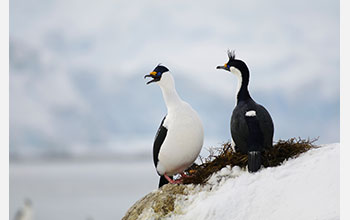Multimedia Gallery
Two blue-eyed shags near the Antarctic Peninsula
Two blue-eyed shags near the Antarctic Peninsula. Blue-eyed shags and cormorants belong to the same family. In the breeding season the adult bird has a white dorsal patch, bright orange nasal caruncles and a blue orbital ring. They build their nests of seaweed, feathers, driftwood and cement it with excrement. Two or three eggs are laid between October and January.
The National Science Foundation runs the U.S. Antarctic Program (USAP). In addition to maintaining three U.S. research stations on the continent, USAP supports research projects in an array of scientific disciplines including, for example, aeronomy and astrophysics, biology and medicine, geology and geophysics, glaciology, and ocean and climate systems. Outreach such as the Antarctic Artists and Writers program and education programs are also supported. For more information about USAP, visit the program's website Here. [Note: Please see special restrictions regarding use of this image, below.] (Date of Image: September 2012)
Credit: Sean Bonnette
Special Restrictions: [Note: Any commercial use of this image requires the photographer's permission.]
Images and other media in the National Science Foundation Multimedia Gallery are available for use in print and electronic material by NSF employees, members of the media, university staff, teachers and the general public. All media in the gallery are intended for personal, educational and nonprofit/non-commercial use only.
Images credited to the National Science Foundation, a federal agency, are in the public domain. The images were created by employees of the United States Government as part of their official duties or prepared by contractors as "works for hire" for NSF. You may freely use NSF-credited images and, at your discretion, credit NSF with a "Courtesy: National Science Foundation" notation.
Additional information about general usage can be found in Conditions.
Also Available:
Download the high-resolution JPG version of the image. (4.9 MB)
Use your mouse to right-click (Mac users may need to Ctrl-click) the link above and choose the option that will save the file or target to your computer.

